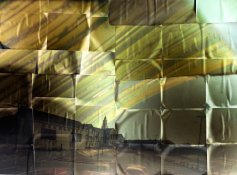Wow, that is... genius. Seriously, I don't have the right words to tell how much I like it

I did a few solargraphics myself, but they were mostly on tiny pieces of paper in black 35mm film cans and only exposed for a few days or weeks. The biggest one was a tall tin with three sheets of 9x13cm paper, adding up to 27x13cm or about 10,5x5 inch, and 3 months exposure... that one had me jumping in joy, but yours just made my jaw hit the floor.
I'm inspired to try again with a bigger format and relatively small hole. Maybe 1,5 by 2 feet with a 0,5mm hole for about the same sharpness as your picture.
Thinking about how solargraphy makes a digital scanner necessary, I thought of another, completely analog way... What about taking a photo of the exposed sheets with positive film (medium or large format for best resolution) and enlarge that onto paper for a true positive silver print of the solargraphic negative? The paper negative can be exposed to a little light before going completely dark (it already does so in the scanner), so that shouldn't be a problem when you're fast enough. A diffused flash might be useful to minimize unnecessary exposure... Of course, I wouldn't try that with such a big project and the danger of destroying it, but I think it's possible if you're careful. I'll try it next week with a small camera that has been sitting on the windowsill for 10 days.
As for the colors: Those are usually completely random and rarely as realistic as in this picture. I don't know where exactly they come from, but I think it's just the color correction in the scanner doing something funky. Definitely not the black and white paper magically turning into a color negative by overexposure (unless I misunderstood the whole chemistry of silverbased paper). I usually got reddish purple skies with bluish sun and corrected them afterwards, since it was digital anyway.
@Existing Light:
You would lock yourself out of your darkroom for months? Are you mad? And for the motif just put something pretty in front of it... "Now for your portrait, please hold perfectly still for a few days"















